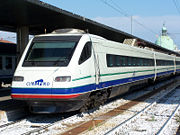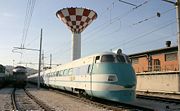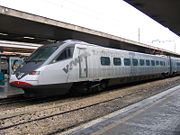Pendolino

Pendolino (from Italian Pendolo ['pɛndolo] "Pendulum" and -ino, a diminutive suffix) is an Italian family of tilting trains used in Italy, Spain, Portugal, Slovenia, Finland, the Czech Republic, Slovakia, the United Kingdom, Switzerland, China and shortly in Romania, Ukraine and Russian Federation. It was developed and manufactured by Fiat Ferroviaria, which was taken over by Alstom in 2002.
The idea of a tilting train became popular in the 1960s and 1970s when various rail operators, impressed by the high-speed rail services being put into place in France and Japan, wondered how they could similarly speed up travel without building a dedicated parallel rail network (as those two countries were doing). By tilting, the train could round curves designed for slower trains at higher speeds without causing undue discomfort to passengers.
Contents |
Italy
In Italy various possibilities along these lines were explored (including one early design for fixed carriages with tilting seats). A number of prototypes were built and tested, including an automotrice (self-propelled) derived from ALn 668 diesel car and provided with tilting seats. The first working prototype using a tilting carbody was ETR Y 0160, an electric-powered car launched by FIAT in 1969. This prototype was the first to be christened Pendolino.

This led to the construction to a whole EMU in 1975, the ETR 401, built in two units by FIAT. One was put into public service in 1975 on the Rome-Ancona (later extended to Rimini) line, operated by Italian State Railways. The train had four cars, and was mostly considered a travelling laboratory for the new technology. The second unit was adapted for service to the wide gauge RENFE Spanish lines.
In 1982 FIAT acquired patents for the tilting bogie used in the ill-fated British project APT. This and other improvements led to the introduction of the more advanced ETR 450, the first Pendolino to enter regular service in the world. Characterized by an 8-car (later 9-car, with the addition of a restaurant coach) configuration, ETR 450 could run the Rome-Milan line in less than 4 hours, at speeds up to 250 km/h. Passengers carried increased from 220,000 in 1988 to 2.2 million in 1993.
In 1993 the next generation, the ETR 460, styled by Giorgetto Giugiaro, began service. Though plagued by technical teething problems, the ETR 460 introduced several innovations, such as more power-packed AC asynchronous motors. Further, the pistons actuating the anti-tilting action were placed in the bogie instead than on the carbody sides: this permitted the reorganisation of the vestibules and passenger compartment areas, improving comfort. The bogie-to-body connection is extremely simple and easy to make, with clear advantages for maintenance. For safety and comfort reason, maximum tilting was reduced from the 13° of ETR 450 to 8°.

ETR 460 keeps axle load to an extremely low level (14.5 ton/axle) in order to allow the train to negotiate curves at a speed up to 35% faster than conventional Intercity trains (loco plus coaches). The body, which exploits large aluminium extrusion technology, has substantial modularity and allows for extremely low axle weight, whilst fully respecting the highest safety standards, and allows the best exploitation of the space with different loading gauges.
ETR 460 was built in only 10 units. Improved version include ETR 470 for the Italo-Swiss Cisalpino company, and the ETR 480, used by Trenitalia under AC lines such as those in France and Switzerland. A total of 34 EMUs of the ETR 460/470/480 series were built. 10 trains, with only 3-cars, were produced by FIAT for RENFE as Alaris in 1998. For extreme temperatures an adapted version known as Sm3 was manufactured for Finnish railways. The Slovenian SŽ series 310, The Czech Class 680 and the Portuguese Alfa Pendular are also based on ETR 460/470/480.
FIAT Ferroviaria was sold to the French Alstom in 2000. Later developments of the Pendolino technology built in the Italian factories of Alstom include the ETR 610.
Finland
- See also VR Class Sm3
The Finnish model, the Sm3, is based on the ETR 460, adapted to the specific requirements of VR (formerly the Finnish State Railways) and to the cold climatic conditions. The first two units were made in 1995 by Rautaruukki-Transtech, a rolling stock company which was part of Spanish Talgo until 2007, but is now back in Finnish ownership as Transtech Oy. Currently there are a total of 18 units operating.

The electrical traction equipment, with continuous power of 4000 kW, includes GTO chopper/inverter and asynchronous motors.
The trains for VR are composed of 6 vehicles: two traction units, each of which consists of two motor coaches with a 4QC/inverter/converter with four traction motors (one for each bogie), plus a trailer coach with high voltage equipment (25 kV and 50 Hz) and traction transformer; and two end coaches with aerodynamic driving cab. One of the trailer coaches (TTC) has a special featured bar section.
The Finnish Pendolinos have received a lot of bad publicity in Finland for their serious reliability issues, mostly caused by technical problems with their tilting system and couplers. The coupling problems have grown important when the Pendolino network has been extended, requiring coupling and uncoupling at intersection stations. Because of unreliable uncoupling the train units often end up into different places than where they should be, resulting in Pendolinos being replaced by commuter traffic equipment.
Karelian Trains
On August 28, 2007, Karelian Trains, a joint venture between Finnish VR and Russian Railways, ordered four 1520 mm gauge seven-car Pendolinos for use on 220 km/h Saint Petersburg–Helsinki services expected to start in 2010.[1]. The model will be an improved version of the model in use by VR, with specifications better adapted to winter conditions solving the previous coupling problems. [2]
United Kingdom
In 2004 Virgin Trains in the UK began operating custom-designed Pendolino trains known as the Class 390 on its West Coast Main Line (WCML) franchise.
These trains were constructed by Alstom and are leased by Virgin Trains from Angel Trains.
Due to the failure of the WCML upgrade to provide in-cab signalling these units are limited in service to 125 mph (200 km/h) operation rather than their 140 mph (225 km/h) design speed. Virgin Trains are currently examining running these at 135 mph (215 km/h) through the Trent Valley as part of their new WCML Franchise Proposal.
The Class 390 Pendolino are maintained by Alstom (West Coast Traincare) under contract to Virgin Trains until 2012. The main maintenance locations are Wembley, Midlands (Oxley, Wolverhampton), Manchester (Longsight), Glasgow (Polmadie), and Liverpool (minor work only) and several "Traincare Points" along the line of route (such as Euston and Carlisle). Headquarters for West Coast Traincare moved from the former Metro-Cammell factory at Washwood Heath in Birmingham upon its closure in November 2005 to Manchester Longsight depot with some functions being based at a new office facility at Oxley depot.
The DfT has announced that 31 of the exsisting 9 car sets will be lengthened to 11-car length to increase capcity. There will also be 4 new sets built formed of 11 cars and Virgin Rail Projects has been selected to introduce the new trains. The increase in size of units will require major infrastructure changes to allow stations and depots to accommodate the 11-car units.
Two decades earlier British Rail had planned to bring tilting train technology to the same line with the APT project. Technical problems caused by pressure to launch the service early and lack of the political will to provide sufficient funding to overcome them forced the abandonment of this early attempt, although much of the technology was used to design and build Pendolino trains.
On 23 February 2007, a Virgin Trains Pendolino train was derailed near Grayrigg, Cumbria. Virgin chairman Sir Richard Branson credited the Pendolino with saving lives in the crash, describing it to BBC News as being "built like a tank."[3] A report released on the 4th of September 2007 found that faulty points were the cause of the accident.[4]
Portugal

In Portugal the Pendolino is named Alfa Pendular and is operated by the Portuguese state railway company CP. It connects the cities of Braga, Porto, Aveiro, Coimbra, Santarém, Lisbon, Albufeira and Faro, among others, and has a top speed of 220 km/h (136.7 mph). The bogies had to be redesigned for operation on Portugal's broad gauge track, and the trains were assembled by Alstom at the Portuguese Amadora plant.
Slovenia
Slovenian Railways operates on its main lines a Pendolino tilting train, known as series 310, derived from ETR 460. It links the major cities of Slovenia in one line: Koper (only in summer), Ljubljana, Zidani Most, Celje and Maribor, with a frequent service that acts as a high-speed shuttle. Once per day the route from Maribor to Ljubljana is extended as international train to Venice via Monfalcone serving Trieste. For further information, see InterCitySlovenija.
Czech Republic
In 2000 FIAT Ferroviaria undertook an order of construction of Czech tilting train, for which, after its takeover, Alstom provided an improved version of ETR 470. The first set was delivered in 2004 as Pendolino ČD 680. While testing from Břeclav to Brno on November 18, 2004, the Pendolino reached a speed of 237 km/h and created a new Czech railway speed record.

During the testing period, the train had problems with the Czech signalling system. The problems were said to be solved and the trains entered regular service in December 2005 between Prague and Ostrava. As of late January 2006, all five Czech Pendolino trains that had been put in service suffer from software and functional problems. The range of problems was spanning from failing air-conditioning and heating to failures of the tilting control. The supposedly ERTMS compliant control system ATLAS is not able to properly join several discrete systems each based on different software platforms. Similar problems have also been reported from Finland. All problems were fixed.
In December 2006 Czech Pendolino was given permission to operate in Slovakia and Austria. Since 10 December 2006 Czech Railways operates 7 times a day route Prague-Pardubice-Olomouc-Ostrava (SuperCity Pendolino), 2 times a day between Prague-Brno-Vienna (SuperCity Johann Gregor Mendel and SuperCity Smetana) and once a day Prague-Brno-Bratislava (SuperCity Slovenská strela). On December 1st, 2007 a Pendolino derailed in Prague. No one was injured but the train was severely damaged.
China
China Railway High-speed (CRH) purchased technologies from Alstom to assemble 60 sets of high speed EMU trains, which have been named CRH5 and are based on Pendolino trains used in Finland. The CRH5 are non-tilting trains.
The future
Currently, a number of countries in Central and Eastern Europe have ordered Pendolino trainsets. For this reason, the Pendolino-type train is set to be the one with the greatest penetration in the high-speed market of Central and Eastern Europe.
See also
- ElettroTreno
- New Pendolino
- Tilting train
- FIAT Ferroviaria
- Alstom
References
- ↑ "Karelian Trains awards Pendolino contract". Railway Gazette International (2007-09-05). Retrieved on 2007-09-06.
- ↑ "Uudet Pendolinot kestävät talvea", MTV3 News, 18 May 2008
- ↑ [1] "It is a very sad day - Branson." BBC News. 24 February 2007.
- ↑ [2] "Train crash points not inspected " BBC News. 4 September 2007.
|
||||||||||||||
|
|||||||||||
